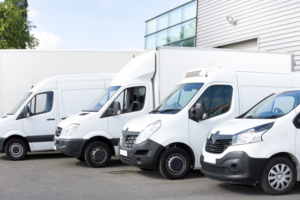Fleet Management Guide
Written by: Simon Pavey, Last updated:16th March 2022

For operators of commercial fleets, going about managing those fleets in the right way is absolutely crucial. That’s because fleet management impacts a business’ profitability, staff, and customer base.
In this guide, we’ll cover off the key aspects of fleet management to help operators stay on top of the best practices used in industry. We’ll specifically touch on subjects including:
- What fleet management is.
- The role of a fleet manager.
- Tips for improving your fleet management.
- Fleet management software.
- Why fleet management matters.
What is fleet management?
Fleet management involves the coordination and organisation of a business’ vehicle portfolio and drivers. This includes not only company-owned cars or vans, but also grey fleet vehicles which are owned by employees but used for work purposes.
Exactly what a fleet management model should look like differs from company to company, and can depend on the number of vehicles managed and the infrastructure and systems in place. However, there are some universal truths to effective fleet management that apply to all businesses at any given stage during their lifecycle.
Some of these key components include:
- Monitoring operational cost.
- Ensuring vehicle safety and compliance.
- Vehicle maintenance and repair.
- Employee management and training.
- Managing operational efficiency and optimisation.
A good fleet manager should be able to keep a legal and safe operation running, engage and motivate workforce, and do so while making cost savings wherever possible.
The role of the fleet manager
The job of the fleet manager is to oversee both the wider strategic movements and the day-to-day operations of a business’ cars, vans, or trucks. Fleet managers have a wide range of responsibilities and so need to be versatile in their skillsets and able to dabble in everything from accountancy to strong communications and the ability to multitask.
Some of the key responsibilities of a fleet manager role include:
Controlling costs
Ensuring operating costs are kept as low as possible is a primary task of the fleet manager. This can include getting a good deal on initial purchases or rentals, as well as keeping ongoing costs down, which could be achieved through improving fuel efficiency or managing the use of services like fuel cards.
Overseeing vehicle maintenance
Keeping your fleet on the road is vital to the success of any business. This means ensuring cars and vans are regularly serviced and checked for any faults. The latest smart technology can alert you to any potential issues before they become a problem, allowing you to plan your schedule and reduce the risk of a breakdown.
Ensuring driver safety
As well as ensuring your fleet is mechanically sound, a good fleet manager should also be keeping an eye on driver behaviour. Tools like telematics systems can keep a full log of their actions, and show you if they were speeding, for instance – or if any harsh inputs have been made on the steering or brakes. This information can enable you step in with training or advice where necessary.
Tracking vehicles
It’s essential that you know where your vehicles are at all times. GPS tracking tools give you a complete picture of your current situation and let you make changes. For instance, it can show you if drivers are taking inefficient routes between jobs and therefore help better plan your operations. What’s more, it can quickly alert you to any unauthorised vehicle use or track down a stolen car.
Ensuring compliance
It’s also up to the fleet management team to ensure their vehicles are road legal and that drivers are meeting their requirements. However, this doesn’t just include keeping MOTs and insurance valid. You should also be tracking any mileage claims for expenses and tax purposes and ensuring drivers aren’t breaching working time rules. This also covers ensuring your drivers are fully licensed for the vehicles they operate. And you’re keeping a record of any issues such as penalty points.
How to improve your fleet management
The most efficient and profitable fleets are likely to be those with the best managers at the helm who can provide structure and processes that are easy to follow, while also ensuring communication with drivers is clear.
Our tips on the key areas in which most fleets could look to upgrade include:
1. Accessing real-time information
The first thing any fleet manager needs in order to work effectively is full visibility of their cars, vans, and drivers. This means having access to real-time data that can show them, at a glance, the location of each vehicle and employee, their current status, and whether they are experiencing any issues.
The most effective way of achieving this is by implementing an effective telematics system. This system connects to a vehicle’s computer and uses a range of sensors to feed data back to a central computer detailing everything a vehicle’s location and speed to driver inputs. Real-time data is also a pre-requisite to many of the solutions we’re about to cover, so if you don’t have it, you could be working with one hand tied behind your back.
2. Implementing GPS tracking
A key part of any real-time information solution will be instant details of your fleet’s locations via GPS. This can be vital if you need to dispatch an employee to a certain destination, as you can see at a glance who is available and best-positioned to respond.
However, it can also be used to help record mileage and hours spent on the road, divert drivers away from areas of congestion and even provide customers with real-time updates on when they can expect your employees to arrive.
3. Improving route planning
GPS tools can also be used in combination with other tech solutions to improve your firms’ route planning. This isn’t just about finding the shortest way from A to B. It should also take into account factors such as expected fuel consumption along the route and the distance to the cheapest filling stations.
For example, if a vehicle is spending a lot of time stuck in traffic with the engine idling, this results in greater fuel consumption and higher costs. With good route planning tools, this can be avoided.
4. Monitoring driver behaviour
Being able to keep an eye on how your employees are driving is also essential. First and foremost, this improves safety. If fleet telematics data shows frequent speeding, or sensors detect harsh control inputs, you can step in to address this. You can even generate league tables that show your best and worst-performing drivers, highlighting who you need to speak to most urgently.
This can also help reduce fuel consumption. By monitoring inputs such as acceleration and braking, you can educate employees to drive more smoothly as well as safely. Indeed, almost half of businesses (49 per cent) using telematics have seen a reduction in speeding incidences and fines, while 55 per cent experienced a drop in fuel usage.
5. Reducing your fuel costs
While better route planning and driver monitoring can help improve your fuel consumption, you should also make sure you’re not paying over the odds at the pump. To do this, it pays to have a suitable fuel card for your usage.
There are a wide range of products to choose from, so it’s important to get this right. It may be the case that the cheapest option isn’t very convenient for your firm. You also need to consider whether you’d benefit from cards with wider motorway networks, for example, and which brands have locations nearest your most common routes.
6. Predictively scheduling maintenance
Breakdowns can be a major headache for fleet managers. Beyond the direct costs associated with fixing vehicle problems, having vehicles off the road unexpectedly also hurts the firm’s productivity. You can avoid this by using the data taken from telematics systems to predictively schedule maintenance. These tools can highlight potential issues and allow you to step in before they turn into serious problems.
7. Automating your expenses
Admin work is often among the most time-consuming parts of a fleet manager’s job. Working out details such as mileage claims, expenses, fuel MPG and other details are essential but tedious activities. But with the right fleet management systems, this doesn’t have to be the case.
Being able to calculate these figures automatically, based on data recorded by the telematics system, doesn’t just free up your time. It also ensures the data is accurate and can highlight any unusual events – such as vehicles doing significantly more miles than expected – for investigation.
8. Setting up security alerts
Spotting and cracking down on unauthorised vehicle usage is also essential. For example, you can set up alerts that let you know if a vehicle is being used outside normal office hours. You can also establish geofencing to warn you if a car from your portfolio travels beyond a certain area.
This isn’t only useful for identifying any employees using company assets for personal use, but it can also help you quickly track down any stolen vehicles – using GPS tracking to guide police precisely.
9. Tackling fuel fraud
Another major concern for many fleet managers is the risk of fuel fraud, such as employees filling personal vehicles using a company fuel card or making claims for miles they haven’t done. Telematics can help spot issues with expenses, while a good fuel card can also help by ensuring vehicle locations match fuel card usage, for example.
10. Managing your vehicle inventory
A good fleet management system can also help keep track of your vehicle inventory. This allows you to better plan ahead for replacements, get alerts when services or MOTs are due, and prepare your finances.
You can also see at a glance details such as the types of fuel used, which will be important to know when selecting a fuel card, and can factor into future buying decisions. For instance, if the majority of your fleet is petrol-powered, you may want to consider phasing out any remaining diesels to simplify your operations.
11. Procuring the right fleet vehicles
It’s crucial that your vehicle portfolio is properly equipped to meet the needs of your business, and there are a lot of considerations you could make around whether to bring new vehicles on board, or upgrade existing cars and vans. A good starting point is to analyse the fuel they’re currently using, and gain visibility over all car running costs.
From there, you can factor in market movements such as the growth of electric vehicles when making judgements on how to go about upgrading your fleet over the coming months and years.
Fleet management software solutions
Many of the efficiencies fleet operators can look to make stem from using the latest and greatest technology in market to automate, track and calculate ways to improve performance.
To recap some of the key pieces of commercial fleet technology we’ve mentioned in this article, the essential software includes:
- A thorough telematics system, such as our Tele-Gence service – which can help businesses take control of vehicle management.
- A mileage tracker system, such as our MileageCount service.
- Fleet software for automating vehicle checks. This can be done through our My Drive Safe mobile app service.
- Software to cheapen maintenance costs. The team at Fuel Card Services can help fleet operators get access to pre-negotiated maintenance rates at thousands of garages across the UK.
- Software to help drivers with their daily operations. For example, our My Drivers Club app can help drivers find their nearest fuel pumps with ease.
Having a good technology stack behind a fleet operation can also prove an attractive prospect for new drivers and partners, who may be accustomed to enjoying these benefits when offered by rival businesses.
Why is fleet management important?
In this article, we have covered what fleet management is, an overview of the fleet manager role, and helpful software solutions, but what is likely to be the impact of upgrading your fleet management processes today?
Some real-world benefits you could see within your fleet include:
- Improved employee productivity.
- A reduction in fuel costs – which could have a significant impact on your bottom line.
- Saving time by controlling your fleet online and eliminating administrative tasks.
- Reduced mileage claims.
- Automated reporting dashboards.
- Improved driver safety and security.
If you want to know more about how Fuel Card Services could help you and your business, you can get in contact with our fleet management experts today.
back







